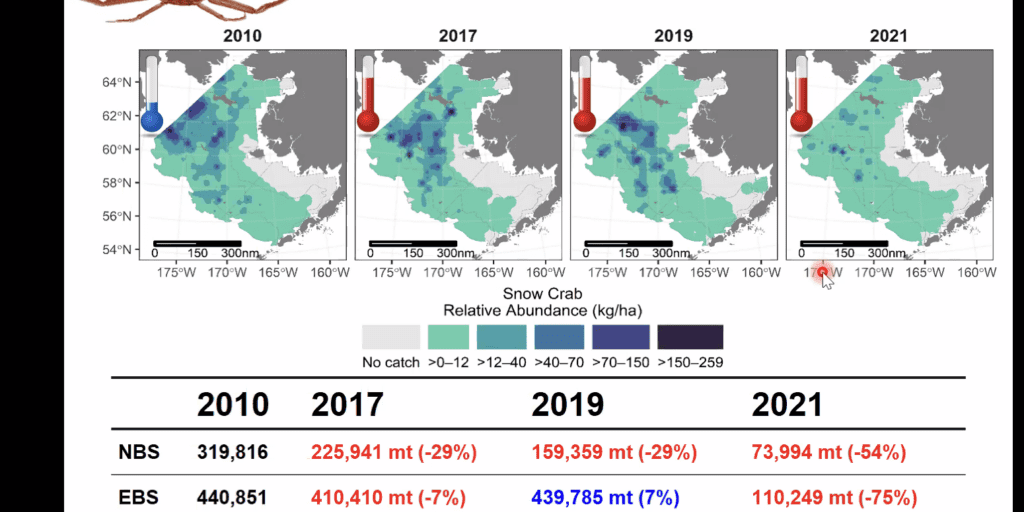Multiple fish populations in the Bering Sea have experienced a slight decline, according to the 2021 Bottom Trawl survey.
Every year the National Oceanic and Atmospheric Administration, or NOAA, conducts the bottom trawl survey, using a net to collect samples of the sea life that resides near the bottom of the ocean floor. The survey examines elements of marine life such as fish population sizes, distribution of species across the Bering Sea, fish diets and environmental data.
Although the survey had to be cancelled in 2020, due to COVID-19 restrictions, this year’s survey proceeded as normal in the late summer.
NOAA Research biologist Lyle Britt covered 21 marine species, including snow crab, pacific herring, purple orange sea star, bering flounder, Alaska skate, arctic cod, pacific cod and pacific walleye pollock. Species that typically live closer to the surface of the Bering Sea were covered in NOAA’s the Top Trawl survey, which will be reviewed in the next Strait Sciences presentation.
Britt explained that the Bering Sea has been fluctuating between warm and cold phases for several years now, so this current warm phase is not unusual.

“At this moment we’ve been in a very long stanza for warming. But we’ve dropped down a little bit. Both not only on the bottom temperatures but the surface temperatures. And I think there’s kind of a hope that maybe we are going to see us go into a cold stanza for a while, and start to cool down the Southeastern Bering Sea. But, this might also just be a little bit of variation, and (it will) jump back up. Next year is going to tell us a whole lot about what is happening,” Britt said.
In regards to the fish populations, Britt reported an overall decline but there are some exceptions. For example, Pacific capelin and Arctic cod showed an increase in the North Bering Sea while the northern neptune whelk, bering flounder, purple orange sea star and rainbow smelt showed an increase in the East Bering Sea. The pacific halibut and red king crab also showed signs of increase. All other fish showed signs of decline throughout the Bering Sea.

One population in significant decline over the past year is the snow crab. Britt explained how the snow crab quantity has changed since 2010.
“And since that year, as conditions have warmed, that number has declined in the Northern Bering Sea. It dropped 29% in 2017 to 225,000. It dropped 159,000, another 29%, in 2019 and in 2021, it dropped 54%,” Britt said.
Other species displaying large declines in the Bering Sea include walleye pollock, saffron cod, and various types of jellyfish.
As Britt pointed out, this news may have a negative impact on subsistence fishers, but it is not as bleak as it sounds.
“I get a little hesitant when I hear words like ecosystem collapse get thrown around. What we are seeing now in my mind is: this is an ecosystem that’s very much in flux. And so, we have very rapid change in distribution. We’re also probably having very rapid change in winners and losers on a kind of a regional scale. That stuff becomes really hard to add up. The ecosystem is quick to go to an equilibrium. When we are seeing so much change, I think it’s really hard to do that kind of calculation thing: ‘have we lost a carrying capacity.’ I think we need a little more data,” Britt said.
The next Strait Sciences presentation will occur via zoom on Nov. 11. Research biologist, Jim Murphy, will look at the results of the Top Trawl survey.
Image at top: Changes in Snow Crab population and distribution starting in 2010. Photo Courtesy of NOAA.




